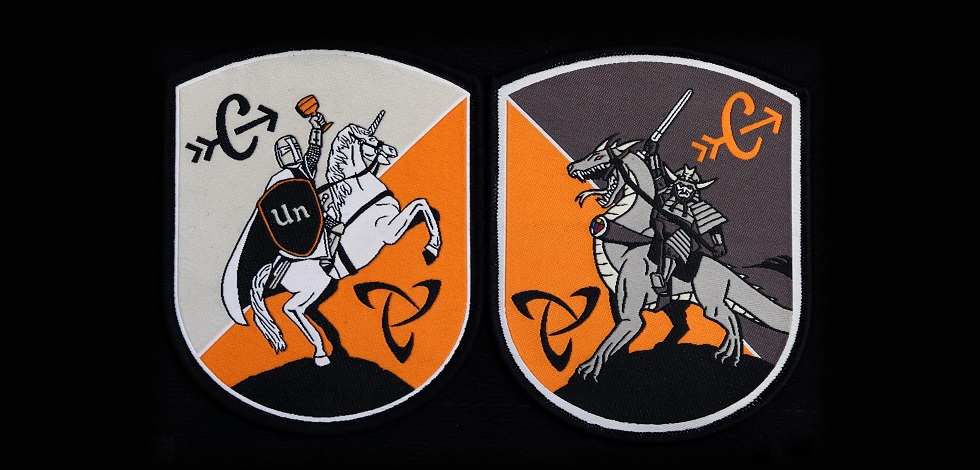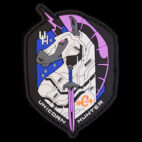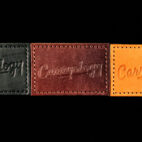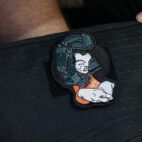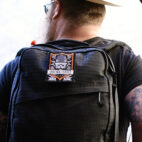Unicorn/Dragon Patch Design Story and Symbolism
One patch design is light.
One patch design is dark.
One patch is inspired by the West.
One patch is inspired by the East.
An equal opposite balance.
Yin and Yang.
When the two patches are displayed next to each other, as intended, they visually interact. The characters and beasts are riding towards each other, towards battle, or maybe towards peace. Or maybe both at the same time. Or maybe on different timelines.
On the Carryology Assault (AKA “Unicorn”)…
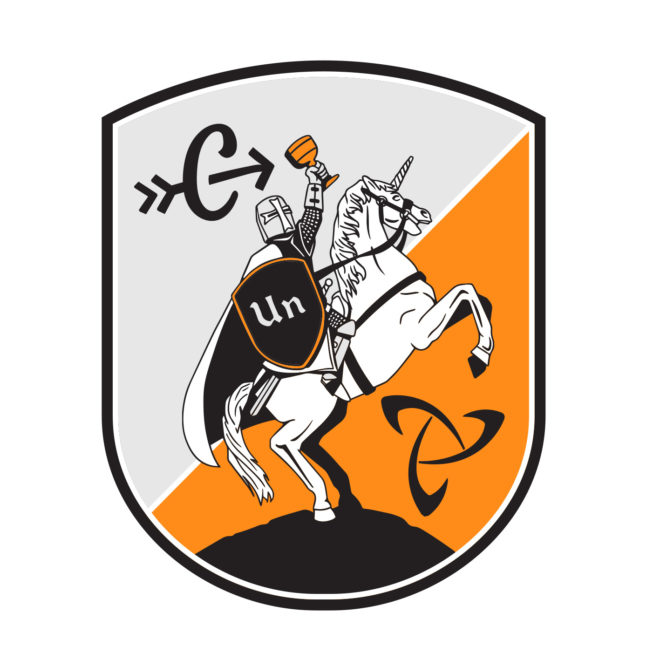
The Carryology Assault gets its simplified nickname “Unicorn” from the most prominent feature on the patch.
We have a medieval (1) Knight riding a (2) Unicorn, holding a (3) Holy Grail, with a shield made of (4) Unobtanium.
All four of these items come from Western culture.
Symbolism:
1. Knight:
Legendary warrior from the West. This character is the only “real” thing of these four items, as documented throughout history.
2. Unicorn:
Famous mythological creature from the West. Believed by some to be real, proof of this animal’s existence has never been presented. No bones, no photos, nothing. Yet some still believe these creatures are out there.
3. Holy Grail:
This blurs the lines between reality, fiction, and the gods. It was believed to and still is believed to exist. People searched their entire lives to find this, yet there is limited evidence to prove its existence. To those who believe, it exists because of their belief in it.
4. Unobtanium:
The human creation of a thing which can never be attained, the embodiment of “impossible to acquire”. A humorous term coined by aerospace engineers for materials that they wished for but did not exist on the periodic table. Today, gear hunters use this term, relating to the gear which they cannot find, but continue to search for.
On the No Escape (AKA “Dragon”)…
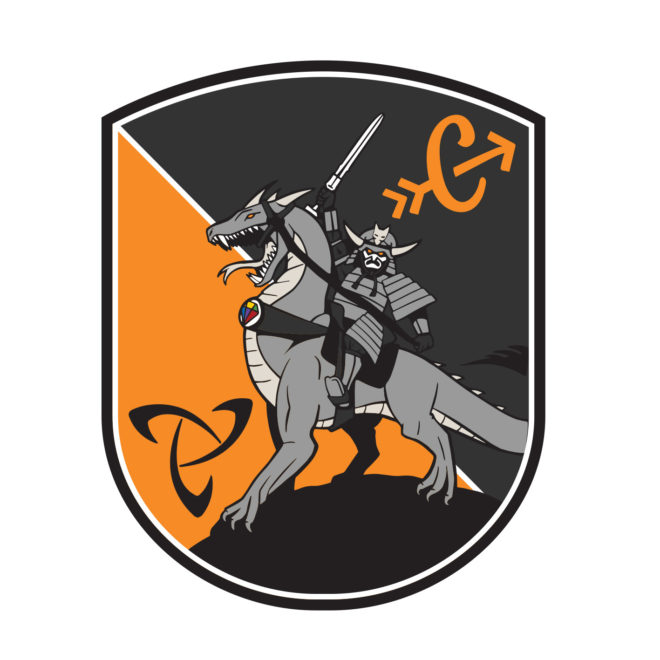
The No Escape gets its simplified nickname “Dragon” from the most prominent feature on the patch.
We have an ancient (1) Samurai warrior atop a (2) Dragon, holding a uniquely-shaped (3) Sword, with a (4) Five-Colored Jewel.
All four of these items come from Eastern culture.
Symbolism:
1. Samurai:
Legendary warrior from the East. This character is the only “real” thing of these four items, as documented throughout history.
2. Dragon:
Famous mythological creature from the East. Believed by some to be real, proof of this animal’s existence has never been presented. No bones, no photos, nothing. Yet some still believe these creatures are out there.
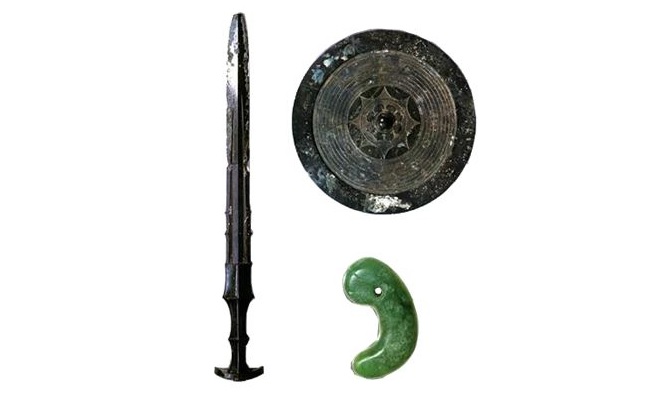
3. Sword:
This blurs the lines between reality, fiction, and the gods. It was believed to and still is believed to exist. It is called Kusanagi-no-Tsurugi (“Grass-Cutting Sword”) and it is one of three items of the Imperial Regalia of Japan. These three items are kept in three different locations across Japan and are covered from view and heavily guarded. This particular sword was believed to have been discovered by Susanoo (god of storms and seas) after defeating an eight-headed serpent and finding the sword in one of its tails.
Since then, it has been passed down the line of Japanese Emperors. Since 690, the three items (including this sword) have been presented to the Emperor during the enthronement ceremony. This ceremony is not public, and these items are by tradition seen only by the Emperor and certain priests. Because of this, no known photographs or drawings exist. Two of the three treasures (the jewel and the sword), as well as the Privy Seal and State Seal, were present at the abdication of Emperor Akihito on 30 April 2019. Akihito’s successor, Naruhito, formally took possession of them in a brief ceremony on 1 May 2019. Prior to these events, they were last in public during the accession and enthronement of Akihito in 1989 and 1990. On all of these occasions, they remained shrouded from view in packages or boxes the entire time.
No living human has ever seen these items. There is much speculation as to the actual origins of these items, what they actually look like, and whether they actually even exist at all.
4. Five-Colored Jewel:
From a 9th-century Japanese folklore story called “The Tale of the Bamboo Cutter”. The story goes that a poor old man (a bamboo harvester) and his wife discovered a tiny baby infant inside a glowing stalk of bamboo. They took the tiny infant and raised her as their very own daughter and named her Kaguya-hime (“Shining Princess of the Young Bamboo”). Later, they realize, because of her, every time he cuts a stalk of bamboo, there is a nugget of gold inside. The family becomes rich and the old man tries to keep Kaguya-hime a secret from the outside world. But quickly, the tale of her beauty and her abilities make its way across the land, bringing five suitors to ask for her hand in marriage.
However, Kaguya-hime is not interested in any of these suitors. She gives each suitor an incredible quest. If they can achieve this task, they can have her hand in marriage. However, what they did not know is that each task she had given them was entirely impossible to achieve.
One of these five tasks given to a suitor was to bring her a five-colored jewel from a dragon’s neck. The driving motivation keeps the individual searching for eternity, despite never being able to acquire it. Do dragons even exist? Where do they live? How would one go about finding a dragon? If one were to somehow find a dragon… would it be the specific dragon that wears a five-colored jewel around its neck? And finally, how would one even remove the jewel from a mighty dragon’s neck? Rarer than rare, this item does not even exist.
Knight & Samurai.
Unicorn & Dragon
Holy Grail & Sword.
Unobtanium & Five-Colored Jewel.
Note: We worked closely with our friend Alexander Ryu Long (born, raised, and living in Japan) to help select these symbols in order to tell this story through imagery on this No Escape morale patch. Fun fact, his name “Ryu” actually means “Dragon” in Japanese. Thank you, Alexander! Illustration work performed by the incredibly talented Hadrien Monloup (one of the founders of Carryology, among a dozen other hats he wears). Thank you, Hadrien!





 Carry Awards
Carry Awards Insights
Insights Liking
Liking Projects
Projects Interviews
Interviews
